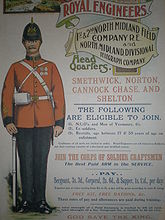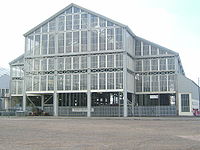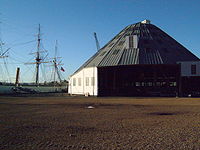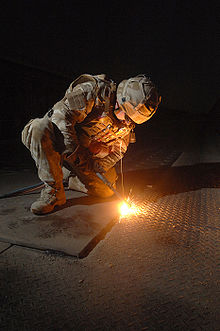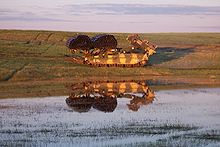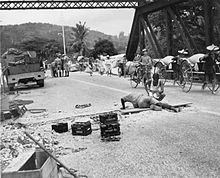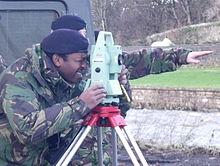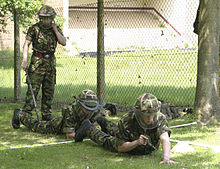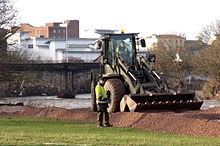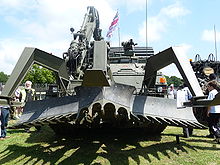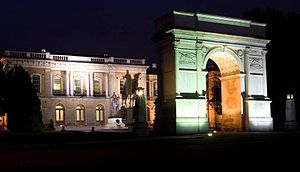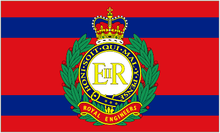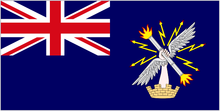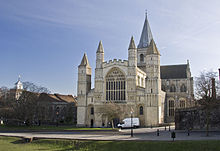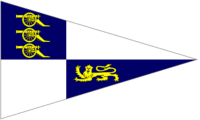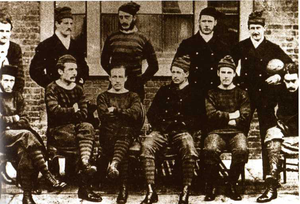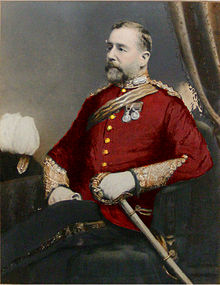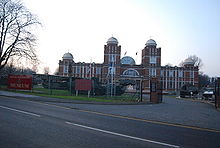- Royal Engineers
-
British Army Arms and Services Combat Arms Royal Armoured Corps Infantry Army Air Corps Combat Support Arms Royal Artillery Royal Engineers Royal Corps of Signals Intelligence Corps Combat Services Royal Army Chaplains Department Royal Logistic Corps Army Medical Services Royal Electrical and Mechanical Engineers Adjutant General's Corps Small Arms School Corps Royal Army Physical Training Corps General Service Corps Corps of Army Music The Corps of Royal Engineers, usually just called the Royal Engineers (RE), and commonly known as the Sappers, is one of the corps of the British Army.
It provides military engineering and other technical support to the British Armed Forces and is headed by the Chief Royal Engineer. The Regimental Headquarters and the Royal School of Military Engineering are in Chatham in Kent, England. The corps is divided into several regiments, barracked at various places in the United Kingdom of Great Britain and Northern Ireland and Germany.
History
 Corps of Royal Engineers Cypher
Corps of Royal Engineers Cypher
The Royal Engineers trace their origins back to the military engineers brought to England by William the Conqueror, specifically Bishop Gundulf of Rochester Cathedral, a talented military engineer, and claim over 900 years of unbroken service to the crown. Engineers have always served in the armies of the Crown; however, the origins of the modern corps, along with those of the Royal Artillery, lie in the Board of Ordnance established in the 15th century. In 1717, the Board established a Corps of Engineers, consisting entirely of commissioned officers. The manual work was done by the Artificer Companies, made up of contracted civilian artisans and labourers. In 1782, a Soldier Artificer Company was established for service in Gibraltar, and this was the first instance of non-commissioned military engineers. In 1787, the Corps of Engineers was granted the Royal prefix and adopted its current name and in the same year a Corps of Royal Military Artificers was formed, consisting of non-commissioned officers and privates, to be officered by the RE. Ten years later the Gibraltar company, which had remained separate, was absorbed and in 1812 the name was changed to the Corps of Royal Sappers and Miners.
In 1855 the Board of Ordnance was abolished and authority over the Royal Engineers, Royal Sappers and Miners and Royal Artillery was transferred to the Commander-in-Chief of the Forces, thus uniting them with the rest of the Army. The following year, the Royal Engineers and Royal Sappers and Miners became a unified corps as the Corps of Royal Engineers. In 1862 the corps also absorbed the British officers and men of the engineer corps of the East India Company.
In 1911 the Corps formed its Air Battalion, the first flying unit of the British Armed Forces. The Air Battalion was the forerunner of the Royal Flying Corps and Royal Air Force.
In 1915, in response to German mining of British trenches under the then static siege conditions of World War I, the corps formed its own tunnelling companies. Manned by experienced coal miners from across the country, they operated with great success until 1917, when after the fixed positions broke, they built deep dugouts such as the Vampire dugout to protect troops from heavy shelling.
The Corps has no battle honours, but its motto is Ubique Quo Fas et Gloria Ducunt. This translates to "Everywhere Where Right and Glory Lead" and is often seen shortened to simply "Ubique" although the full motto should always be used for traditional, heraldic or historical purposes. The motto was granted by King William IV in 1832, signifying that the Corps had seen action in all the major conflicts of the British Army and almost all of the minor ones as well. The Royal Engineers Museum of Military Engineering is in Gillingham in Kent.
A point of some pride to the Sappers is that their name takes the form Corps of Royal Engineers rather than, for example, Royal Engineer Corps. The distinction, they say, is that every Sapper is Royal in his own right, rather than simply being a member of a Royal Corps (such as the Royal Corps of Signals or the Royal Regiment of Artillery).
Before the Second World War, Royal Engineers recruits were required to be at least 5 feet 4 inches tall (5 feet 2 inches for the Mounted Branch). They initially enlisted for six years with the colours and a further six years with the reserve or four years and eight years. Unlike most corps and regiments, in which the upper age limit was 25, men could enlist in the Royal Engineers up to 30 years of age. They trained at the Royal Engineers Depot in Chatham or the RE Mounted Depot at Aldershot.[1]
Honourable Conquests and Historical Construction
Britain having acquired an Empire, it fell to the Royal Engineers to conduct some of the most significant 'civil' engineering schemes around the world. Some examples of great works of the era of empire can be found in A.J. Smithers' book; 'Honourable Conquests':
Royal Albert Hall
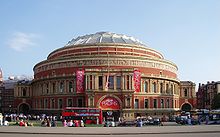 The Royal Albert Hall, designed by Captain Francis Fowke RE.
The Royal Albert Hall, designed by Captain Francis Fowke RE.
The Royal Albert Hall is one of the UK's most treasured and distinctive buildings, recognisable the world over. Since its opening by Queen Victoria in 1871, the world's leading artists from every kind of performance genre have appeared on its stage. Each year it hosts more than 350 performances including classical concerts, rock and pop, ballet and opera, tennis, award ceremonies, school and community events, charity performances and lavish banquets.
The Hall was designed by Captain Francis Fowke and Major-General Henry Y.D. Scott of the Royal Engineers and built by Lucas Brothers.[2] The designers were heavily influenced by ancient amphitheatres, but had also been exposed to the ideas of Gottfried Semper while he was working at the South Kensington Museum.
Indian Infrastructure
Much of the infrastructure of India, still enjoyed today, was created by engineers of the three presidencies armies and the Royal Engineers. Lieutenant (later General Sir) Arthur Thomas Cotton (1803–99), Madras Engineers, was responsible for the design and construction of the great irrigation works on the river Cauvery, which watered the rice corps of Tanjore and Trichinopoly districts in the late 1820s. In 1838 he designed and built sea defences for Vizagapatam. He masterminded the Godavery Delta project where 720,000 acres (2,900 km2) of land were irrigated and 500 miles (800 km) of land to the port of Cocanada was made navigable in the 1840s. Such regard for his lasting legacy was shown when in 1983, the Indian Government erected a statue in his memory.
Other irrigation and canal projects included the Ganges Canal, where Colonel Sir Colin Scott-Moncrieff (1836–1916) acted as the Chief Engineer and made modifications to the original work. Scott-Moncrieff went on to become Under Secretary of State Public Works, Egypt where he restored the Nile barrage and irrigation works of Lower Egypt.
Rideau Canal
The construction of the Rideau Canal was proposed shortly after the War of 1812, when there remained a persistent threat of attack by the United States on the British colony of Upper Canada. The initial purpose of the Rideau Canal was military, as it was intended to provide a secure supply and communications route between Montreal and the British naval base in Kingston, Ontario. Westward from Montreal, travel would proceed along the Ottawa River to Bytown (now Ottawa), then southwest via the canal to Kingston and out into Lake Ontario. The objective was to bypass the stretch of the St. Lawrence River bordering New York State, a route which would have left British supply ships vulnerable to attack or a blockade of the St. Lawrence. The construction of the canal was supervised by Lieutenant-Colonel John By of the Royal Engineers. In 2007 it was inscribed as a UNESCO World Heritage Site recognizing it as a work of human creative genius. The Rideau Canal was recognized as the best preserved example of a slack water canal in North America demonstrating the use of European slackwater technology in North America on a large scale. Lt. Denison was one of the junior Royal Engineers who worked under Lt. Colonel John By, RE on the Rideau Canal in Upper Canada (1826–1832). Of note, Denison carried out experiments under the direction of Lt. Col. By to determine the strength, for construction purposes of the old growth timber in the vicinity of Bytown. His findings were published by the Institution of Civil Engineers in England who bestowed upon him the prestigious Telford Medal.
Dovers' Western Heights
The Western Heights of Dover are one of the most impressive fortifications in Britain. They comprise a series of forts, strong points and ditches, designed to protect the country from invasion. They were created to augment the existing defences and protect the key port of Dover from both seaward and landward attack. First given earthworks in 1779 against the planned invasion that year, the high ground west of Dover, England, now called Dover Western Heights, was properly fortified in 1804 when Lieutenant-Colonel William Twiss was instructed to modernise the existing defences. This was part of a huge programme of fortification in response to Napoleon's planned invasion of the United Kingdom. To assist with the movement of troops between Dover Castle and the town defences Twiss made his case for building the Grand Shaft in the cliff:
‘...the new barracks.....are little more than 300 yards horizontally from the beach.....and about 180 feet (55 m) above high-water mark, but in order to communicate with them from the centre of town, on horseback the distance is nearly a mile and a half and to walk it about three-quarters of a mile, and all the roads unavoidably pass over ground more than 100 feet (30 m) above the barracks, besides the footpaths are so steep and chalky that a number of accidents will unavoidably happen during the wet weather and more especially after floods. I am therefore induced to recommend the construction of a shaft, with a triple staircase....the chief objective of which is the convenience and safety of troops....and may eventually be useful in sending reinforcements to troops or in affording them a secure retreat.’
Twiss’ plan was approved and building went ahead. The shaft was to be 26 feet (7.9 m) in diameter, 140 feet (43 m) deep with a 180 feet (55 m) gallery connecting the bottom of the shaft to Snargate Street, and all for under an estimated £4000. The plan entailed building two brick-lined shafts, one inside the other. In the outer would be built a triple staircase, the inner acting as a light well with ‘windows’ cut in its outer wall to illuminate the staircases. Apparently, by March 1805 only 40 feet (12 m) of the connecting gallery was left to dig and it is probable that the project was completed by 1807.
Pentonville Prison
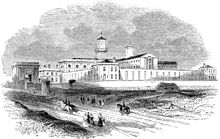 Pentonville Prison designed by Capt Joshua Jebb RE.
Pentonville Prison designed by Capt Joshua Jebb RE.
Two Acts of Parliament allowed for the building of Pentonville Prison for the detention of convicts sentenced to imprisonment or awaiting transportation. Construction started on 10 April 1840 and was completed in 1842. The cost was £84,186 12s 2d.Captain (later Major General Sir) Joshua Jebb designed Pentonville Prison, introducing new concepts such as single cells with good heating, ventilation and sanitation.
Boundary Commissions
Although mapping by what became the Ordnance Survey was borne out of military necessity it was soon realised that accurate maps could be also used for civic purposes.The lessons learnt from this first boundary commission were put to good use around the world where members of the Corps have determined boundaries on behalf of the British as well as foreign governments; some notable boundary commissions include:
- 1839 - Canada-United States
- 1858 - Canada-United States (Captain (later General Sir) John Hawkins RE)
- 1856 and 1857 - Russo-Turkish (Lieutenant Colonel (later Sir) Edward Stanton RE)
- 1857 - Russo-Turkish (Colonel (later Field Marshal Sir) John Simmons RE)
- 1878 - The Bulgarian
- 1880 - Græco-Turkish (Major (later Major General Sir) John Ardagh RE)
- 1884 - Russo-Afghan (Captain (later Colonel Sir) Thomas Holdich RE)
- 1894 - India-Afghanistan (Captain (later Colonel Sir) Thomas Holdich RE)
- 1902 - Chile-Argentine (Colonel Sir Delme Radcliffe RE)
- 1911 - Peru-Bolivia (Major AJ Woodroffe RE)
Much of this work continues to this day. The reform of the voting franchise brought about by the Reform Act (1832), demanded that boundary commissions were set up. Lieutenants Dawson and Thomas Drummond (1797–1839), Royal Engineers were employed to gather the statistical information upon which the Bill was founded, as well as determining the boundaries and districts of boroughs. It was said that the fate of numerous boroughs fell victim to the heliostat and the Drummond light, the instrument that Drummond invented whilst surveying in Ireland. (In 1835 he resigned his commission on his appointment as Under Secretary of State for Ireland).
Abney Level
A Topographic Abney Level is an instrument used in surveying which consists of a fixed sighting tube, a movable spirit level that is connected to a pointing arm, and a protractor scale. The Topographic Abney Level is an easy to use, relatively inexpensive, and when used correctly an accurate surveying tool. The Abney level was invented by Sir William de Wiveleslie Abney (Born 24 Jul 1843 Died 3 Dec 1920) who was a Royal Engineer, an English astronomer and chemist best known for his pioneering of color photography and color vision. Sir Abney invented this instrument under the employment of the Royal School of Military Engineering in Chatham, England in the 1870s.
H.M. Dockyards
In 1873, Captain Henry Brandreth RE was appointed Director of the Department of Architecture and Civil Engineering, later the Admiralty Works Department. Following this appointment many Royal Engineer officers superintended engineering works at Naval Dockyards across the world.
Early in the 19th century, cast, wrought and corrugated iron came to be used in dockyard buildings, replacing wood as the material for frames and cladding. The experience of the Corps made them experts in the use of these new materials.
Chatham Dockyard
Chatham being the home of the Corps, meant that the Royal Engineers and the Dockyard had a close relationship since Captain Brandreth's appointment. At the Chatham Dockyard, Captain Thomas Mould RE designed the iron roof trusses for the covered slips, 4, 5 and 6. Slip 7 was designed by Colonel Godfrey Greene RE on his move to the Corps from the Bengal Sappers & Miners. In 1886 Major Henry Pilkington RE was appointed Superintendent of Engineering at the Dockyard, moving on to Director of Engineering at the Admiralty in 1890 and Engineer-in-Chief of Naval Loan Works, where he was responsible for the extension of all major Dockyards at home and abroad. It was under his supervision that the Royal Naval Hospital, Chatham, was built in 1905.
Trades
All members of the Royal Engineers are trained combat engineers and all sappers (privates) and non-commissioned officers also have another trade. Women are eligible for all Royal Engineer specialities.
ME - Armoured operating an AVRE in Canada
All Sappers train as Military Engineer - Combat. Sappers then qualify one of the following additional trades:
- Military Engineer - Armoured Crewman
- Military Engineer - Bricklayer and Concretor
- Military Engineer - Bomb Disposal
- Military Engineer - Building and Structural Finisher
- Military Engineer - Carpenter and Joiner
- Military Engineer - Command, Communications and Information Systems Specialist
- Military Engineer - Construction Materials Technician
- Military Engineer - Draughtsman (Design)
- Military Engineer - Draughtsman (Electrical and Mechanical)
- Military Engineer - Driver
- Military Engineer - Electrician
- Military Engineer - Fabricator (Welder)
- Military Engineer - Fitter (Air Conditioning and Refrigeration)
- Military Engineer - Fitter (General)
- Military Engineer - Geographical Technician
- Military Engineer - Heating and Plumbing
- Military Engineer - Plant Operator Mechanic
- Military Engineer - Resources Specialist
- Military Engineer - Surveyor (Engineering)
- Military Engineer - Surveyor (Topographical)
Later, sappers can specialise in further trades and specialities, including:
- Counter Terrorist Advanced Search
- Explosive Ordinance Disposal
- Amphibious Engineer
- Clerk of Works (Construction)
- Clerk of Works (Electrical)
- Clerk of Works (Mechanical)
- Commando Engineer
- Army Diver
- Military Plant Foreman
- Parachute Engineer
- Regimental Signals Instructor
Senior NCOs who have passed the appropriate Clerk of Works course can be commissioned as Garrison Engineers (Construction, Electrical or Mechanical).
Units
The Royal Engineers comprises units of both the Regular Army and the Territorial Army. There is also a higher engineer formation:
Theatre Troops
- 8 Force Engineer Brigade
- 12 (Air Support) Engineer Group (25 and 39 Engineer Regiments, 529 Specialist Teams (STRE)RE)
- 29 (Land Support) Engineer Group (33 and 101 (V) Regiments)
- 170 (Infrastructure Support) Engineer Group (previously Military Works Force)
- HQ Works Group
- Royal Engineers Specialist Advisory Team (RESAT)
- Technical Information Centre Royal Engineers
- 62 Works Group (Water utilities, water development and well drilling)
- 506 STRE (Water Infrastructure) (Volunteers)
- 519 STRE (Works)
- 523 STRE (Works)
- 521 STRE (Water Development)
- 63 Works Group (Electrical power generation and distribution)
- 504 STRE (Power Infrastructure) (Volunteers)
- 518 STRE (Works)
- 528 STRE (Power)
- 535 STRE (Works)
- 64 Works Group (Fuels, fuel production and distribution)
- 516 STRE (Fuels)
- 524 STRE (Works)
- 527 STRE (Works)
- 65 (Volunteers) Works Group (Civilian infrastructure, railway and ports infrastructure)
- STRE
- STRE
- STRE
- STRE
- STRE
- 66 Works Group (Air Support and geotechnical engineering)
- 510 STRE (Volunteers)
- 517 STRE (Works)
- 522 STRE (Works)
- 530 STRE (Materials)
- 67 Works Group
- 502 STRE (Works)
- 505 STRE (Works)
- HQ Works Group
Regiments
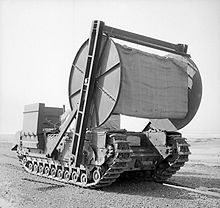 Armoured Vehicle Royal Engineers, Bobin, on D Day
Armoured Vehicle Royal Engineers, Bobin, on D Day RE Plant Operators construct foundations for a new bridge in Workington after floods
RE Plant Operators construct foundations for a new bridge in Workington after floods Sappers launching a Logistic Support Bridge at Workington in order to reduce effects of collapsed bridges
Sappers launching a Logistic Support Bridge at Workington in order to reduce effects of collapsed bridges
- 21 Engineer Regiment
- 7 Headquarters and Support Squadron
- 1 Armoured Engineer Squadron
- 4 Armoured Engineer Squadron
- 73 Armoured Engineer Squadron
- 22 Engineer Regiment
- 6 Headquarters and Support Squadron
- 3 Armoured Engineer Squadron
- 5 Armoured Engineer Squadron
- 52 Armoured Engineer Squadron (2008)
- 23 Engineer Regiment (Air Assault) - part of 16 Air Assault Brigade
- 12 (Nova Scotia) Headquarters and Support Squadron (Air Assault)
- 9 Parachute Squadron
- 51 Parachute Squadron
- 299 Para Field Squadron (V) [Wakefield/Hull/Gateshead]
- 24 Commando Engineer Regiment - (Attached to 3 Commando Brigade, Royal Marines) - (based at Chivenor). As part of the restructuring of the armed forces in 2004, it was announced that the engineering support for 3 Commando Brigade would be increased to a full regiment, with 24 (Commando) Engineer Regiment to be formed.
- 25 Engineer Regiment (In November 2011 it was announced that 25 Engineer Regiment will be disbanded as a savings measure by no later than 31 May 2012.)[3]
- Control of all squadrons passed to 39 Engineer Regiment.
- 26 Engineer Regiment
- 38 Headquarters and Support Squadron
- 8 Armoured Engineer Squadron
- 30 Armoured Engineer Squadron
- 33 Armoured Engineer Squadron (2008)
- 28 Engineer Regiment
- 64 Headquarters and Support Squadron
- 23 Amphibious Engineer Squadron + 412 Troop(Volunteers) TA
- 42 Field Squadron
- 45 Field Support Squadron (Disbanded)
- 65 Field Support Squadron
- 32 Engineer Regiment
- 2 Headquarters and Support Squadron
- 26 Armoured Engineer Squadron
- 31 Armoured Engineer Squadron
- 39 Armoured Engineer Squadron
- 33 Engineer Regiment (Explosive Ordnance Disposal) [Hybrid Regiment with Regular & Territorial Army Squadrons]
- 49 Field Squadron (EOD)
- 58 Field Squadron (EOD)
- 61 Field Squadron (EOD)
- 217 (London) Field Squadron (EOD)(V) {Holloway}
- 101 (City of London) Engineer Regiment (Explosive Ordnance Disposal) [Hybrid Regiment with Regular & Territorial Army Squadrons]
- 22 Headquarters and Support Squadron (EOD)
- 17 Field Squadron (EOD)
- 21 Field Squadron (EOD)
- 221 Field Squadron (EOD)(V) {Rochester/Catford}
- 579 Field Squadron (EOD)(V) {Tunbridge Wells}
- 35 Engineer Regiment
- 44 Headquarters and Support Squadron
- 29 Armoured Engineer Squadron
- 37 Armoured Engineer Squadron
- 77 Armoured Engineer Squadron
- 36 Engineer Regiment (Search)
- 50 Headquarters and Support Squadron (Search)
- 20 Field Squadron (Search)
- 69 Gurkha Field Squadron (Search), Queen's Gurkha Engineers
- 70 Gurkha Field Support Squadron (Search), Queen's Gurkha Engineers
- 38 Engineer Regiment (based at Waterbeach)
- 32 Headquarters and Support Squadron
- 11 Field Squadron
- 15 Field Support Squadron
- 25 Field Squadron
- 39 Engineer Regiment
- 60 Headquarters and Support Squadron (Air Support)
- 10 Field Squadron (Air Support) based at RAF Leeming
- 48 Field Squadron (Air Support)
- 43 Headquarters and Support Squadron (Air Support) (Formally 25 Engr Regt)
- 34 Field Squadron (Air Support) (Formally 25 Engr Regt)
- 53 Field Squadron (Air Support) (Formally 25 Engr Regt)
- 42 Engineer Regiment (Geographic)
- 13 Geographic Squadron
- 14 Geographic Squadron ( based in Munchengladbach)
- 16 Geographic Support Squadron
- 62 Cyprus Support Squadron Royal Engineers (British Forces Cyprus)
The Royal School of Military Engineering
The Royal School of Military Engineering is the British Army's Centre of Excellence for Military Engineering, Explosive Ordnance Disposal (EOD), and counter terrorist search training. Located on several sites in Chatham, Kent, Camberley in Surrey and Bicester in Oxfordshire the Royal School of Military Engineering offers superb training facilities for the full range of Royal Engineer skills.
The RSME was founded by Major (later General Sir) Charles Pasley, as the Royal Engineer Establishment in 1812.[4] It was renamed the School of Military Engineering in 1868 and granted the "Royal" prefix in 1962.[5]
- Royal School of Military Engineering
- Combat Engineer School
- 3 Royal School of Military Engineering Regiment
- 55 Training Squadron Royal Engineers
- 57 Training Squadron Royal Engineers
- 63 Training Support Squadron Royal Engineers
- Communication Information Systems Wing
- 3 Royal School of Military Engineering Regiment
- Construction Engineer School
- 1 Royal School of Military Engineering Regiment
- 24 Training Squadron Royal Engineers
- 36 Training Squadron Royal Engineers
- Civil Engineering Wing
- Electrical and Mechanical Wing
- 1 Royal School of Military Engineering Regiment
- Royal Engineers Warfare Wing (Founded in 2011 and split between Brompton Barracks, Chatham and Gibraltar Barracks, Kent, this is the product of the amalgamation between Command Wing, where Command and Tactics were taught and Battlefield Engineering Wing, where combat engineering training was facilitated.)
- United Kingdom Mine Information and Training Centre
- Defence Explosive Munitions and Search School (formally Defence EOD School and the National Search Centre)
- Defence Animal Centre
- Royal School of Military Survey (until 1 April 2006)
- Combat Engineer School
- 28 Training Squadron, Army Training Regiment Bassingbourn
- Diving Training Unit (Army), (DTU(A))
- Band of the Corps of Royal Engineers
Territorial Army
 Royal Monmouthshire RE (Militia) Capbadge.
Royal Monmouthshire RE (Militia) Capbadge.
- Royal Monmouthshire Royal Engineers (Militia)
- 100 Field Squadron [Cwmbran/Bristol/Cardiff]
- 101 Headquarters Troop [Monmouth]
- 108 (Welsh) Field Squadron [Swansea/Gorseinion]
- 225 Field Squadron [Birmingham]
- The Jersey Field Squadron [St Helier]
- 71 Engineer Regiment (Volunteers) (Air Support)
- 102 (Clyde) Field Squadron (Air Support) [Paisley/Barnsford Bridge]
- 124 Field Squadron (Cumbernauld)
- 236 Field Squadron [Elgin]
- Headquarters Troop RAF Leuchars
- 10 Orkney Field Troop [Orkney Islands]
- 72 Engineer Regiment (Volunteers) Close Support
- 103 (Tyne Electrical Engineers) Field Squadron (Air Support) [Newcastle/Sunderland(2Tp)]
- 106 (West Riding) Field Squadron [Sheffield/Bradford]
- 73 Engineer Regiment (Volunteers) (Air Support)
- 129 Headquarters and Support Squadron [Nottingham]
- 350 Field Squadron (Air Support) [Nottingham]
- 575 (Sherwood Foresters) Field Squadron (Air Support) [Chesterfield]
- 75 Engineer Regiment (Volunteers) (Field)
- 107 (Lancashire and Cheshire) Field Squadron [Birkenhead]
- 125 (Staffordshire) Field Support Squadron [Stoke-on-Trent]
- 202 Field Support Squadron [Manchester]
- 101 (City of London) Engineer Regiment (EOD) [Hybrid Regiment - Regular & TA]
- 221 Field Squadron (EOD)(V) [Rochester/Catford]
- 579 Field Squadron (EOD)(V) [Tunbridge Wells]
- 33 Engineer Regiment (EOD) [Hybrid Regiment - Regular & TA]
- 217 (London) Field Squadron (EOD) [Holloway]
- 131 Independent Commando Squadron Royal Engineers (Volunteers) [London/Bath/Plymouth/Birmingham] ' formed 24 Commando Regiment Royal Engineers in early 2007
- 135 Independent Geographic Squadron Royal Engineers (Volunteers) [Ewell]
- Engineer and Logistic Staff Corps (Volunteers)
- 170 (Infrastructure Support) Engineer Group (previously Military Works Force)
- 62 Works Group [Regular]
- 506 STRE (Water Infrastructure)
- 63 Works Group [Regular]
- 504 STRE (Power Infrastructure)
- 64 Works Group [Regular]
- 503 STRE (Fuels Infrastructure)
- 65 Works Group
- 507 STRE (Railway Infrastructure)
- 509 STRE (Ports Infrastructure)
- 508 STRE (Works)
- 525 STRE (Works)
- 526 STRE (Works)
- 62 Works Group [Regular]
- 591 Independent Field Squadron
- Is the only Royal Engineer TA Unit in Northern Ireland.
Corps' Ensign
The Royal Engineers, Ports Section, operated harbours and ports for the army and used mainly specialised vessels such as tugs and dredgers. Although the former Submarine Mining Service badge had been incorporated into their Ensign, which was been designated 'Royal Engineers' after Submarine Mining was transferred to the Admiralty in 1904, the badge was made obsolete in 1909. However at the beginning of the 1914-1918 War, Inland Water Transport (IWT), previously part of the War Department Fleet, was transferred to the Royal Engineers and in 1915 the old Submarine Mining/Royal Engineers badge was reintroduced with pattern again sealed (L of C 17226).
IWT ran barges on rivers and canals up to the front line in France. Later their responsibilities were extended, and by 1916 they were also operating ships and train ferries across the Channel from a purpose built port at Richborough. IWT vessels were also in East Africa, and Mesopotamia (Iraq) where they moved supplies on the Tigris and Euphrates from Basra to Baghdad; by 1918 over 1600 vessels were there, mainly chartered or requisitioned. IWT was disbanded in 1924, but revived in 1939. During the 1939-1945 War IWT was active in North Africa, India, British Malaya, Burma, Iraq, Normandy, Belgium, and the Netherlands.
In November 1942 the Director of Transportation asked whether the flag issued to Royal Engineers small craft was correct. He seems to have been concerned with the form of the thunder-bolt. The original 1806 crest from which the badge was derived; "Out of a mural crown a dexter hand holding a thunderbolt all proper", had been changed in 1823 to "Out of a mural crown, argent, a dexter cubit arm the hand grasping a thunderbolt, winged and in flames, proper". Sir Gerald W. Wollaston, Inspector of Regimental Colours, wrote "thunderbolts are always subject to treatment", and in a later letter, "Wings and lightning should emanate from the body of the thunder-bolt of which they are a constituent part. In the badge the wings seem to float behind the hand. A thunder-bolt is a winged body (of no very definite formation perhaps) from which emanate flashes of lightning."
Ensigns with the revised badge were made in two sizes, 6' x 3' and 3' x 1.5', (183/ 91/ 46 cm). Small numbers were ordered in 1943 and early 1944, probably for training units, but in June orders were placed for 2,514 six feet ensigns and 1,982 three feet ensigns, for operational service.
After the war the army continued to have two separate water-borne transport organisations, Royal Engineers (Transport Services) operating ports and bulk movement in bases and on lines of communication, and Royal Army Service Corps responsible for intercommunication and distribution movements. In July 1965 the Royal Army Service Corps Fleet (civilian and military) and the Royal Engineers Fleet (Port Squadrons & Inland Water Transport) merged to form the Royal Corps of Transport Fleet.
The Royal Engineers ensign was later flown on boats of the RE Berlin Squadron and at the Royal Engineers Diving Training Wing at Gunwharf, Portsmouth. It presumably disappeared in 1996, when all Service diving moved to the Joint Service Defence Diving School on Hornsea Island, Portsmouth, it made a brief reappearance on one of the landing- craft beached at Arromanches during the 60th anniversary of D-Day celebrations and was flown by both 37 and 29 Armoured Engineer Squadrons on boats conducting anti-rocket patrols in the rivers and marshes of Southern Iraq in 2009.
Bishop Gundulf, Rochester and King's Engineers
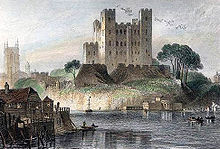 Rochester Castle from across the Medway. Engraving from image by G.F. Sargent c1836.
Rochester Castle from across the Medway. Engraving from image by G.F. Sargent c1836.
Bishop Gundulf, a monk from the Abbey of Bec in Normandy came to England in 1070 as Archbishop Lafranc's assistant at Canterbury. His talent for architecture had been spotted by King William I and was put to good use in Rochester where he was sent as Bishop in 1077. Almost immediately the King appointed him to supervise the construction of the White Tower, now part of the Tower of London in 1778.[clarification needed] Under William Rufus he also undertook building work on Rochester Castle. Having served three Kings of England and earning 'the favour of then all' Gundulf is accepted as the first "King's Engineer". Gundulf died in 1108 and his statue adorns the West door of Rochester Cathedral.
Because of his military engineering talent, Bishop Gundulf is regarded as the 'father of the Corps of Royal Engineers'. The Corps claims a line of Kings' Engineers pre-dating the Engineers of the Board of Ordnance,1414, and the formal founding of the Corps in 1716, all the way back to Gundulf. This shared heritage and the close proximity to the Cathedral of the Royal School of Military Engineering in Brompton, Medway means the Corps of Royal Engineers and Rochester Cathedral maintain strong links to this day, including holding the Corps' annual veterans and remembrance services at the Cathedral.
There are over 25 memorials to individual Officers and Soldiers of the Corps of Royal Engineers and a number of memorials representing members of the Corps that have given their lives in the discharge of their duty, including many stained glass windows presented by the Corps. The interior wall surrounding the West Door (the main entrance) is entirely given over to a mosaic memorial to the Corps' dead from campaigns of the Victorian era, including previous forays into Afghanistan.
The Institution of Royal Engineers (InstRE)
See also: Institution of Royal Engineers and RE - Continuous Professional Development.
 The Institution Badge, taken from the Corps' Cypher
The Institution Badge, taken from the Corps' Cypher
The Institution of Royal Engineers (InstRE), the professional institution of the Corps of Royal Engineers, was established in 1875 and in 1923 it was granted its Royal Charter by King George V. The Institution is co-located with the Royal Engineers Museum, within the grounds of the Royal School of Military Engineering at Brompton in Chatham, Kent.
The Institution Today
The present objectives of the Institution are to promote and advance the science of military engineering and to promote the military efficiency of the Corps of Royal Engineers. In pursuit of these objects the Institution provides a forum for debate through its sponsorship of joint professional meetings; the publication of articles in its Journal; the maintenance of a Museum and Library for the Corps' heritage and archive collection; and the administration of prize funds, a memorials fund and a scholarship fund.
Members of the InstRE are awarded the post-nominal letters MInstRE. The Institution is a licensed member of the Engineering Council and was granted permission to award Engineering Technician (EngTech) status in 2007. In 2010 the institution was granted the ability to award Incorporated Engineer (IEng) and Chartered Engineer (CEng) status to suitably experienced and qualified Military Engineers who are members of the Institution.
There are several categories of membership:
- Fellowship (FInstRE) of the Institution is conferred on members of note by the Council. This is a personal honour and is not conferred on the holder of an office as such.
- Membership (MInstRE) of the Institution is open to serving and retired officers, warrant officers, senior and junior NCOs, both Regular and Territorial, of the Corps of Royal Engineers, and to those who are of similar rank in the engineer arm of the land forces of Commonwealth countries, and such other friendly nations as the Council of the Institution shall determine.
- Honorary Members (HonMInstRE) are elected by the Council. This is a personal honour and is not conferred on the holder of an office as such. Members of the Royal Engineers are not eligible for election as Honorary Members.
- Honorary Associate Membership is reserved for the Chief Engineers of the armed forces of friendly nations and others who by their appointment hold an office with whom the Institution have an affiliation.
- Associate Membership is no longer offered. In the streamlining of membership existing Associate Members were granted permission to become full members on application.
The Institution currently publishes a journal, less formal magazine and supports a number of books and papers:
- Royal Engineers Journal is published three times per year and contains articles that have some military engineering connection. The first Journal was published in August 1870. The idea for the publication was proposed at the Corps Meeting of May 1870 by Major R Harrison and seconded By Captain R Home, who became its first editor. (The Journal eventually superseded the Professional Papers, which were started by Lieutenant WT Denison in 1837 and continued to be published until 1918).
- Royal Engineers List is a list of all serving and retired officers and warrant officers. The first list was published in 1876 as part of the Journal, in 1905 it became a separate publication.
- History of the Corps of Royal Engineers is currently in its 12th volume. The first two volumes were written by Major General Whitworth Porter and published in 1889.[6] The most recent Volume was published in October 2011 and covers the years 1980 to 2000.
- The Sapper is a monthly magazine for all ranks first published in August 1895. It was originally proposed by three Corporals; Piggott, Avis and Beaumont and was taken up by Engineer Clerk Sergeant SW Hirst. The first few editions were published at the School of Military Engineering (SME) Printing School. Today, past issues of The Sapper Magazine can be viewed, free, online.
The Institution, in line with the aims of the Engineering Council supports Continuous Professional Development of all serving members of the Corps. The Corps manages CPD through the Royal Engineers Continuous Personal Development (RE-CPD) Team. The RE CPD Team is still managed and funded by the Royal Engineers Vocational Education & Training Trust (REVETT). The Trust is a registered Charity (number 1068709) largely funded through the Learning & Skills Council but also has access to limited Ministry of Defence funding.
Based in Chatham at the Royal School of Military Engineering, the RE CPD Team is the driving force behind most RE CPD activity and is directly involved in many qualifications schemes. The Team supports the provision of qualifications & training in many of the skills areas associated with military engineering, including construction, civil, electrical and mechanical engineering, surveying, cartography and telecommunications.
History of the Institution
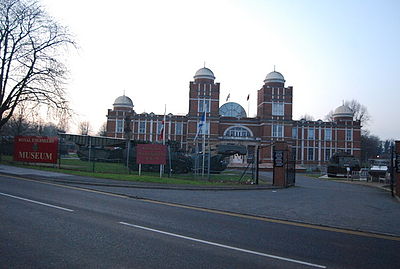 The Ravelin Building at the Royal School of Military Engineering, Chatham, is now home to the Institution and Corps Museum.
The Ravelin Building at the Royal School of Military Engineering, Chatham, is now home to the Institution and Corps Museum.
The expansion of the British Empire during the 1860s, and in particular the absorption of the officer engineer elements from the former East India Company Army into the Corps of Royal Engineers in 1862 created the need and wish for further opportunities for the officers to study technical issues to better enable them to met the challenges of their work. This led to the suggestion of a Royal Engineer Institute, to house a technical library and a Museum.
In 1869 a Royal Commission on Military Education was set up to investigate education within the armed services. In 1871 a proposal to build accommodate for both the Institute and parts of the School of Military Engineering was laid before the Commission. The proposal was accepted and construction began on the building. It was designed by Lieutenant (later Sir) Montague Ommanney, Royal Engineers in 1872, who went on to become King of Arms of the Order of St Michael and St George, the herald of the Order of St Michael and St George. The Institute Building was completed at the end of 1873, since the Institutions move the building has become the Headquarters of the Royal School of Military Engineering.
In 1875 a report on the proposed founding of an Institute was submitted to the Commander-in -Chief and the Secretary of State for War, who approved it. Thereafter the Institute came into being when it was accepted at the Corps Meeting in May 1875.
It was initially called the 'Royal Engineer Institute', but in 1882 an 's' was added to the name 'Engineer' in all Corps Associations, so the Institute became the 'Royal Engineers Institute'. The title was again changed to the 'Institution of Royal Engineers' (InstRE) in 1923 when it was incorporated by Royal Charter.
Captain VG Clayton, Royal Engineers, acted as a temporary Secretary until Major WH Collins, Royal Engineers, was appointed Secretary in August 1875, but soon resigned and the position was taken over by Captain RH Vetch, Royal Engineers, in July 1876. He held the post until January 1884 and laid the foundations on which the Secretary's duties grew and continued until the First World War (1914–18).
In 1910, owing to a shortage of Royal Engineer Officers, permission to employ an officer in the post of Secretary on the active list was withdrawn, but a Government grant was secured to cover the salary of the Secretary who was to be elected from officers on the reserve or retired lists.
The home of the Institute was the Institute Building at Chatham although in 1887 a committee was appointed to consider the question of the provision of premises in London. In 1984 the Institution moved into the Ravelin Building to be co-located with the Corps museum and other 'regimental' activities.
The Royal Engineers' Association
The Royal Engineers Association was formed under the conditions of a Deed of Declaration of Trust by the amalgamation of the original Royal Engineers Association and the Royal Engineers Benevolent Fund Ltd on 19 November 1968. The original Royal Engineers Association was founded in 1912 under the name of The Royal Engineers Old Comrades Association. Its name was changed to the Royal Engineers Association in 1952. The Royal Engineers Benevolent Fund Ltd was originally established as the RE Charitable Fund in 1868. It was incorporated as a Friendly Society on 29 January 1925 and changed its name to the RE Benevolent Fund on 23 July 1943.
The Aims of The Association are to promote and support the Corps among members of the Association in the following ways:
- By fostering esprit de corps and a spirit of comradeship and service.
- By maintaining an awareness of Corps traditions.
- By acting as a link between serving and retired members of the Corps.
- To provide financial and other assistance to serving and former members of the Corps, their wives, widows and dependants who are in need through poverty.
- To make grants, within Association guidelines, to the Army Benevolent Fund and to other charities which further the objectives of the Association.
The Association is organised into a Headquarters, Groups and Branches. The Association Headquarters are located at the Royal School of Military Engineering at Brompton, Chatham. Group Headquarters are located geographically to supervise and organise Branches. Branches are established in towns, districts or units of the Corps and are administered by their elected Branch officials. There are also a growing number of National Branches which relate to various activities within the Corps. Currently these are:
- Bomb Disposal,
- Military Survey,
- Armoured Engineers,
- Radio,
- Junior Leaders,
- Airborne Engineers,
- Amphibious Engineers,
- Commando Engineers,
- Plant,
- Postal and Courier (RE).
Royal Engineers' Yacht Club
 Un-defaced Blue Ensign flown by members of the REYC.
Un-defaced Blue Ensign flown by members of the REYC.
Watermanship being one of the many skills required of the Sapper led to the formation of a sailing club in 1812 and later to the development of cutter rowing teams.
In 1899 the General Officer Commanding Thames and Medway, the Royal Engineer General Sir Charles Warren (1840–1927) presented a challenge shield for a championship cutter race on the River Medway against the Royal Navy. The Sapper teams were drawn from members of the Submarine Mining School, but when the service was disbanded in 1905, the tradition of cutter rowing was continued by the fieldwork squads.
The club developed and became the Royal Engineer Yacht Club in 1846, making it one of the most senior yacht clubs in the United Kingdom. The REYC continues to this day, operating three club yachts and competing on behalf of the Corps at races around the world. The club is one of the oldest sports clubs in the British Army.
Members of the REYC, as one of the oldest clubs in the UK, are permitted to apply for permission to fly an Un-defaced Blue Ensign along with the REYC Burgee which is formed from cannons and lions of the shield of the coat of arms of the Board of Ordnance.
The Royal Engineers A.F.C.: The first combination team (late 1860s to mid 1870s)
Sir Frederick Wall (who was the secretary of the Football Association from 1895–1934) states in his biography that the early combination game was first used by the Royal Engineers A.F.C. in the early 1870s, in particular prior to their 1873 tour of Nottingham, Derby and Sheffield .[7][8][9] Wall states that the "Sappers moved in unison" and showed the "advantages of combination over the old style of individualism". He goes on to state that they were the first "to show the value of combination in Sheffield and Nottingham.[10] Wall attended and regularly refers to the 1872 international match in his account (see below) and speaks very highly of many Scottish teams and players he does not attribute the combination game to either of these. The Engineers were also capable of dribbling the ball, for example one 1868 match reports states "Lieut Morris got off and dribbling the ball quite round his opponents, brought it in front of the goal and a kick from Lieut Dorward scored the first goal for the Royal Engineers".[11]
Royal Engineers in 1868
By early 1868 a contemporary match report states "For the R.E.s Lieuts Campbell, Johnon and chambers attracted especial attention by their clever play"[12]
Royal Engineers in 1869
As early as 1869 the Royal Engineers football club is documented in a contemporary match report as having "worked well together" and "had learned the secret of football success - backing up".[13] In this match failure of the opposite team was attributed to "a painful want of cooperation" against the Engineers.
Royal Engineers in 1870
Another contemporary match report clearly shows that by 1870, ball passing was a feature of the Engineers style: "Lieut. Creswell, who having brought it up the side then kicked it into the middle to another of his side, who kicked it through the posts the minute before time was called"[14]
Royal Engineers in 1871
Although brief, contemporary match reports confirm that passing was a regular feature of the Engineers' style. For example in a match of February 1871 against Crystal Palace it is noted that "Lieut Mitchell made a fine run down the left, passing the ball to Lieu. Rich, who had run up the centre, and who pinced another [goal]" [15] The Engineers used their team playing style with effect against the Wanderers FC, a side considered as early as 1870 to be the MCC of football.[16] In a match of March 1871 against Wanderers their victory was due to "irreproachable organisation" and in particular that both their attacks and their backing up were both "so well organised"[17] In November 1871 similar passing tactics are described in a contemporary account of a game against the Wanderers in which two goals were scored through tactical passing: "Betts, however, soon seized his opportunity, and by a brilliant run down the left wing turned the ball judiciously to Currie, who as judiciously sent it flying through the strangers' goal in first rate style"[18] Later in the match it is reported that "Lieut G Barker, turning the ball to Lieut Renny-Tailyour who planted it between the posts"[18] "Turning" the ball clearly points to the short pass.
Royal Engineers in 1872
There is evidence that opponents sometimes adjusted their playing style to counteract the organisation and passing of the Engineers. For example in February 1872 against Westminster school a brief contemporary match report states that: "The school captain took the precaution of strengthening his backs, deputizing HDS Vidal to cooperate with Rawson and Jackson and so well did these three play in concert... they succeeded in defying the... RE forwards" [19] What is most notable about this report is that it confirms that the Royal Engineers "played beautifully together"[19] That the engineers were the first side to break the trend of dribbling is shown in a contemporary account of their victory against Crystal Palace in early 1872. This said that: "very little dribbling was displayed" [20]
Summary of the Royal Engineers early playing style
The evidence above contains detailed descriptions of passing that are lacking in reports of the 1872 Glasgow international. For example, in a lengthy account the Scotsman newspaper makes no mention of passing or combination by the Scottish team and specifically describes the Scottish attacks in terms of dribbling: "The Scotch now came away with a great rush, Leckie and others dribbling the ball so smartly that the English lines were closely besieged and the ball was soon behind"[21] and "Weir now had a splendid run for Scotland into the heart of his opponents' territory.[21]" Although the Scottish team are acknowledged to have worked better together during the first half, this contemporary account acknowledges that in the second half England played similarly: "During the first half of the game the English team did not work so well together, but in the second half they left nothing to be desired in this respect.[21]" The Scotsman concludes that the difference in styles in the first half is the advantage the Queens' Park players had "through knowing each others' play" as all came from the same club. Unlike the 1872 Glasgow international - which was drawn - the contemporary evidence above shows that the Engineers' team playing style benefited their team play by winning games. Similarly, the 5th March 1872 match between Wanderers and Queens park contains no evidence of ball passing[22]
The early accounts cited above all confirm that the Engineers were the first club to play a passing game of cooperation and organisation with both their forwards and their defence. Although they could also play rough - as would be expected for an army team - The Engineers are the first side to be considered to play the football "beautifully".[19] All of these developments clearly occurred before and independent of the 1872 match between England and Scotland (Queen's Park FC). It is probable that Queen's Park FC observed the Engineers' passing game during one of their visits to England to participate in the 1871–72 FA Cup. Undoubtedly, their representatives in London were well aware of the Sheffield and Engineers' style.
Rugby
The Army were represented in the very first international by two members of the Royal Engineers, both playing for England, Lieutenant Charles Arthur Crompton RE and Lieutenant Charles Sherrard RE.[23]
Successor units
Several units have been formed from the Royal Engineers.
- The Air Battalion Royal Engineers (formed 1911) was the precursor of the Royal Flying Corps (formed 1912) which evolved into the Royal Air Force in 1918.
- The Telegraph Battalion Royal Engineers became the Royal Engineers Signals Service, which in turn became the independent Royal Corps of Signals in 1920.
- The Royal Engineers were responsible for railway and inland waterway transport, port operations and movement control until 1965, when these functions were transferred to the new Royal Corps of Transport. (See also Railway Operating Division.)
- In 1908, the Army Postal Corps (formed in 1882) and the Royal Engineers Telegraph Reserve (formed in 1884) amalgamated to form the Royal Engineers Postal Section. This later became the Army Postal and Courier Service and remained part of the RE until the formation of the Royal Logistic Corps in 1993 - see (British Forces Post Office).
The Royal Engineers from just after the Second World War until the early 1970s also had 4 Plant Troops located in the United Kingdom which were RE reinforced Plant & Engineering troops attached to various Home Commands. The Command Plant Troops were initially set up in the late 40s to clear up the beach defences around the coast and remove the minefields and were equipped with Armoured Bulldozers. In the 1950s once all this work was complete they took responsibility of maintaining and building all Army Ranges and various civil works in support of the civilian population and in support of civilian organisations in the event of natural disasters and crises such as the Torrey Canyon disaster where the Southern Command Plant Troop was deployed to the West Country to clean up the mess on the beaches caused by the large volume of oil that floated ashore. The 4 Command Plant Troops were based in various locations across the United Kingdom with Southern Commend Plant Troop initially based in Tidworth, then Perham Down in Wiltshire and eventually Longmoor in Hampshire. The Midlands Plant Squadron was based in Walsall and the Northern Command plant troop was based in Ripon. The other command plant troop was based in Scotland. In Germany there was an Entire Engineering group based in Willich near Düsseldorf called the Military Civilian Plant & Engineering group that had a similar large scale Engineering, Plant and Support role for British Army of the Rhine. Each Command Plant Troop was commanded by an RE Major supported by a Military Plant Foreman.
In 1969, it was decided to amalgamate all of the Command Plant Troops into one large Squadron which had 4 troops, an HQ Troop and a large REME Attachment to it and the Squadron - 66 Plant Squadron became the largest squadron in the entire Royal Engineers, in terms of Plant Engineering and Equipment as well as staff. Its last home was in Longmoor Hampshire - Engineer Stores Depot attached to Longmoor Military Camp, which was also home to a Field Support Squadron. Longmoor Military Railway was from 1901 until the late 1960s the preserve of the Royal Engineers but subsequently Royal Corps of Transport and eventually Royal Logistic Corps Railway Training Centre. Its role also changed with a much wider role to support Military operations throughout NATO.
In late 1976 a Mr Trotter in Parliament asked the Secretary of State for Defence which units, apart from 66 Plant Squadron Royal Engineers, are specialists in heavy plant; whether he still intends to disband this squadron; if so, what unit will take its place; and what will be the reduction in the engineers' heavy plant capacity.
In answer to Mr Trotter 's question (See Hansard - Defence 6 December 1976) Mr. Robert C. Brown replied ...There is no directly comparable regular unit containing a similar concentration of specialist plant expertise, but specialist capability exists in parts of various regular field and base units in the United Kingdom, BAOR and elsewhere. In addition, there are two TAVR plant squadrons. As a consequence of the Defence Review, 66 Plant Squadron, Royal Engineers will disband by early 1978, but most of its heavy equipment will be taken over by other engineer units notably in the TAVR. As a result, there will be some reduction in the capacity of the Royal Engineers to plan and conduct major projects in peacetime.
Notable personnel
- Category:Royal Engineers soldiers
- Category:Royal Engineers officers
Equipment
- Chieftain Armoured Vehicle Royal Engineer (ChAVRE)
- Chieftain Armoured Vehicle Layer Bridge (ChAVLB)
These are being replaced by 66 Armoured Support Vehicles;[24]
- TROJAN is a minefield breaching vehicle. It prepares routes, mark safe routes using an Obstacle Marking System, breach complex obstacles and provide short dry and wet gap crossing utilising its excavator arm, earth moving blade and a midi fascine. It will plough through minefields, build trenches and dig defensive ditches
- TITAN will carry and lay the current range of In-Service Close Support bridges laying them faster, and in a wider variety of terrain conditions, than previous equipment. TITAN can lay a bridge over a 26 metre gap in two minutes, making it the fastest Support Vehicle in the world at this task. This gives commanders a potential battle winning edge and allows them to choose from a more flexible range of armoured vehicles.
Both vehicles which weigh 62.5 tonnes and are powered by 1,200 horsepower engines are capable of speeds of up to 56 km/h, are designed to mount and tow the current range of in-service Royal Engineer equipment (PYTHON, AVRE Trailer, Track/Full Width Mineploughs and earth moving blades). They have purpose designed hulls, will incorporate Special to Role equipment and have major assemblies common to the Challenger 2 Main Battle Tank.
Order of precedence
Preceded by
Royal Regiment of ArtilleryOrder of Precedence Succeeded by
Royal Corps of SignalsDecorations
Victoria Cross
 Victoria Cross and Bar
Victoria Cross and Bar
The following Royal Engineers have been awarded the Victoria Cross (VC), the highest and most prestigious award for gallantry in the face of the enemy that can be awarded to British and Commonwealth forces.
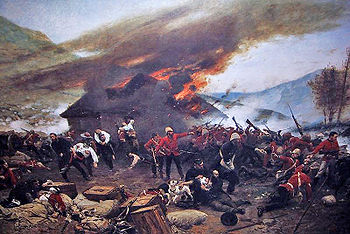 Rorke's Drift, 22–23 January 1879, a battle fought under the command of Lt. John Chard, RE. Eleven Victoria Crosses were won during the battle, including one by Chard. Painting by Alphonse de Neuville
Rorke's Drift, 22–23 January 1879, a battle fought under the command of Lt. John Chard, RE. Eleven Victoria Crosses were won during the battle, including one by Chard. Painting by Alphonse de Neuville
- Tom Edwin Adlam, 1916, Thiepval, France
- Adam Archibald, 1918, Ors, France
- Fenton John Aylmer, 1891, Nilt Fort, India
- Mark Sever Bell, 1874, Battle Of Ordashu, Ashanti (now Ghana)
- John Rouse Merriott Chard, 1879, Rorke's Drift, South Africa
- Brett Mackay Cloutman, 1918, Pont-Sur-Sambre, France
- Clifford Coffin, 1917, Westhoek, Belgium
- James Morris Colquhoun Colvin, 1897, Mohmand Valley, India
- James Lennox Dawson, 1915, Hohenzollern Redoubt, France
- Robert James Thomas Digby-Jones, 1900, Ladysmith, South Africa
- Thomas Frank Durrant, 1942, St. Nazaire, France
- Howard Craufurd Elphinstone, 1855, Sevastopol, Crimea
- George de Cardonnel Elmsall Findlay, 1918, Catillon, France
- Gerald Graham, 1855, Sevastopol, Crimea
- William Hackett, 1916, Givenchy, France
- Reginald Clare Hart, 1879, Bazar Valley, Afghanistan
- Lanoe Hawker, 1915 {While serving with the RFC}
- Charles Alfred Jarvis, 1914, Jemappes, Belgium
- Frederick Henry Johnson, 1915, Hill 70, France
- William Henry Johnston, 1914, Missy, France
- Frank Howard Kirby, 1900, Delagoa Bay Railway, South Africa
- Cecil Leonard Knox, 1918, Tugny, France
- Edward Pemberton Leach, 1879, Maidanah, Afghanistan
- Peter Leitch, 1855, Sevastopol, Crimea
- William James Lendrim, 1855, Sevastopol, Crimea
- Wilbraham Oates Lennox, 1854, Sevastopol, Crimea
- Henry MacDonald, 1855, Sevastopol, Crimea
- James John McLeod INNES, 1859, Sultanpore, India
- Cyril Gordon Martin, 1915, Spanbroek Molen, Belgium
- James McPhie, 1918, Aubencheul-Au-Bac, France
- Philip Neame, 1914, Neuve Chapelle, France
- John Perie, 1855, Sevastopol, Crimea
- Claude Raymond, 1945, Talaku, Burma (now Myanmar)
- John Ross, 1855, Sevastopol, Crimea
- Michael Sleavon, 1858, Jhansi, India
- Arnold Horace Santo Waters, 1918, Ors, France
- Thomas Colclough Watson, 1897, Mamund Valley, India
- Theodore Wright, 1914, Mons, Belgium
Memorials
- Royal Engineers World War I memorial at La Ferté-sous-Jouarre
- National Memorial Arboretum at Alrewas, Staffordshire
- The memorial to the Royal Engineers at Arromanches, the site of the Mulberry Harbours during WW2 - http://www.haworth-village.org.uk/360/1940/arromanches-002.asp
Further reading
- "Follow the Sapper: An Illustrated History of the Corps of Royal Engineers", by Colonel Gerald Napier RE. Published by The Institution of Royal Engineers, 2005. ISBN 0903530260.
- The History of the Corps of Royal Sappers and Miners: From the Formation of the Corps in March 1772, to the Date when Its Designation was Changed to that of Royal Engineers, in October 1856, by Thomas William John Connolly. Published by Longman, Brown, Green, and Longmans, 1857.
- History of the Corps of Royal Engineers, by Whitworth Porter, Charles Moore Watson. Published by Longmans, Green, 1889.
- The Royal Engineer, by Francis Bond Head. Published by John Murray, 1869.
- Papers on Subjects Connected with the Duties of the Corps of Royal Engineers, by Great Britain Army. Royal Engineers. Published by The Corps, 1874.
- Professional Papers of the Corps of Royal Engineers, by Great Britain Army. Royal Engineers, Royal Engineers' Institute (Great Britain). Published by Royal Engineer Institute, 1892.
- The Royal Engineers in Egypt and the Sudan, by Edward Warren Caulfeild Sandes. Published by Institution of royal engineers, 1937.
- Citizen Soldiers of the Royal Engineers Transportation and Movements and the Royal Army Service Corps, 1859 to 1965, by Gerard Williams, Michael Williams. Published by Institution of the Royal Corps of Transport, 1969.
- Royal Engineers, by Derek Boyd. Published by Cooper, 1975. ISBN 0850521971.
- The Royal Engineers, by Terry Gander. Published by I. Allan, 1985. ISBN 0711015171.
- Versatile Genius: The Royal Engineers and Their Maps : Manuscript Maps and Plans of the Eastern Frontier, 1822-1870, by University of the Witwatersrand Library, Yvonne Garson. Published by University of the Witwatersrand Library, 1992. ISBN 1868380238.
See also
 Media related to Royal Engineers at Wikimedia Commons
Media related to Royal Engineers at Wikimedia CommonsReferences
- ^ War Office, His Majesty's Army, 1938
- ^ Oxford Dictionary of National Biography
- ^ "First tranche of Army unit moves confirmed". Ministry of Defence. http://www.mod.uk/DefenceInternet/DefenceNews/DefencePolicyAndBusiness/FirstTrancheOfArmyUnitMovesConfirmed.htm. Retrieved 10 November 2011.
- ^ Corps History Part 6 Royal Engineers Museum
- ^ Corps History Part 17 Royal Engineers Museum
- ^ "Institution of Royal Engineers (InstRE)". Articles. Royal Engineers Museum. http://www.remuseum.org.uk/articles/rem_article_institute.htm. Retrieved 19 November 2010.
- ^ Wall, Sir Frederick (2005). 50 Years of Football, 1884-1934. Soccer Books Limited. ISBN 1-8622-3116-8.
- ^ Cox, Richard (2002) The encyclopaedia of British Football, Routledge, United Kingdom
- ^ History of Football
- ^ Royal Engineers - Football - History
- ^ Bells Life Saturday December 12th 1868, issue2434
- ^ Bells Life Sat March 21, 1868 Issue 2396
- ^ Bell's Life in London and Sporting Chronicle, Saturday December 18th 1869
- ^ Bell's Life in London and Sporting Chronicle, Sat November 5th 1870,issue 2
- ^ Bell's Life in London and Sporting Chronicle, Saturday February 25th 1871, issue 2, 643
- ^ "The Sporting Gazette" of Saturday 12 March 1870, see account of international match of 5 March 1870
- ^ Bell's Life in London and Sporting Chronicle, Saturday March 18th 1871,issue 2, 646
- ^ a b Bell's Life in London and Sporting Chronicle, Saturday November 18th 1871,issue 2, 681
- ^ a b c Bell's Life in London and Sporting Chronicle, Saturday February 17th 1872,issue 2694
- ^ FOOTBALL. Bell's Life in London and Sporting Chronicle (London, England), Saturday, March 16, 1872; pg. 8; Issue 2,698. New Readerships.
- ^ a b c The Scotsman - Monday, 2nd December 1872, page 6
- ^ Bell's Life in London and Sporting Chronicle (London, England), Saturday, March 09, 1872; Issue 2,697
- ^ Army Players and International Representation (1871 onwards)
- ^ MOD Oracle website, News (03 Nov 06): "New Armoured Vehicles Join The Army", (accessed 25 Nov 06)
External links
- Official Royal Engineers MOD Site
- Institution of Royal Engineers
- Royal Engineers - Continuous Professional Development
- Site for finding current and former serving members of the Corps
- 7 Fd Sqn Memories
- 29 Fld Sqn (vets) Association
- 60 HQ & Sp Sqn History
- Royal Engineers Association
- Royal Engineers Museum and Library
- Royal Engineers Band
- The Royal Engineers in Halifax: Photographing the Garrison City, 1870-1885
- The Columbia Detachment of the Royal Engineers, an online history and biographies of the Royal Engineers in colonial-era British Columbia
- Airborne Engineers Association
- Engineering Council UK
- Rochester Cathedral
- History of 555 Field Company Royal Engineers in WW2
Categories:- Military engineering
- British administrative corps
- Corps of Royal Engineers
Wikimedia Foundation. 2010.



